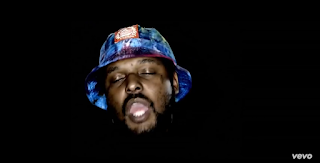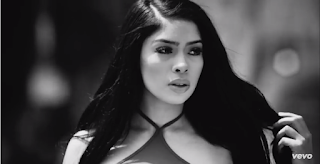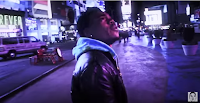Is meaning created through music videos?
In the September 2013 episode of Media Magazine, rapper David Aidoo, aka ThisisDA, discussed 'reading' lyrics in rap songs. He spoke about deciphering the meanings of songs, his writing process and whether or not we should decipher the lyrics at all. As I am creating a music video this year, whilst reading this I couldn't help but apply it to music videos and the way in which they can work in tandem with the lyrics of a song to create an even stronger meaning.
Interpreting Songs
Towards the start of the article Aidoo says that the way music makes us feel is where the 'basic interpretation' of the song's meaning comes from and I think that this feeling we get from a song is completely supported by the music video. Watching, just as much as listening, creates a visceral reaction (Altman), and combining them both together creates synergy between the two products; a good music video together with a good song creates a much bigger reaction than each one on it's own, at least in my opinion, allowing us to interpret in an even stronger way. I think this is most obvious with the music video for Stan by Eminem. The song, contrary to the ideas of Lyotard, has a very strong singular narrative following the story of the character Stan and in this sense it is the perfect song for translating into a music video. This is utilised well in the video, with Eminem almost becoming a narrator for the video.
 |
| "Sometimes I scribble addresses too sloopy when I jot em" |
This screenshot is a clear example of where meaning is added to Eminem's story through the video. It gives a visual representation of the basement in which Stan writes his letters to Eminem. The use of mise-en-scene, particularly the prop of the magazine which has an article open about Eminem. This creates the idea that Stan is obsessed with Eminem, confirmed by the setting, with the pictures of Eminem's face on his wall. This shows a child like fascination which appears unhealthy at Stan's age. The dark lighting also sets a very obvious twisted tone to the video, representing Stan as someone hidden away from society. This clearly shows how meaning can be portrayed through a music video and gives another tool to intepret the music. However, Aidoo debates whether or not we should stick to this raw visceral reaction that the lyrics create.
 |
| Kanye West in the studio |
Visceral Reactions
For example, he tells the story of when he was watching a documentary on Kanye West which shows him producing Late Registration. He tells us that Kanye West inspired him to 'record on the spot' without pre-written lyrics because, in Kanye's words, it allows you to 'connect with the beat more'. This 'connection' is clearly a way of creating a more visceral reaction to music, abandoning a more methodical, intellectual approach. In my opinion this is just as a valid way of producing and writing music as any other, backed up by the 3.1 million sales Kanye's Late Registration has made, making it a triple platinum album. One thing I wondered was whether or not this visceral approach extends to Kanye's music videos and viewing the video for Gold Digger seems to tell me that it does.
 |
| A screenshot from the Gold Digger video |
This screenshot is a good example for the theme of the video; portraying Kanye looking behind his back at a provactively dressed woman. The shots of Kanye and Jamie Foxx singing throughout the video create a very raw visceral image, as do the images of the provactively dressed women on magazine covers. The screenshot itself has been created for a very visceral response. The setting of the shot, with the black background with a red light tells you everything you need to know. The red is a very raw colour, as it can represent ideas of both love and anger, arguably two themes present towards the women referenced in the song. Therefore, I think that a music video gives a very good way of anchoring meaning (Goodwin) from the artists perspective, in this case creating the very raw visceral emotion that the song is looking to create.
 |
| Screenshot from an Eminem video |
Dangers in interpreting songs
Another part of Aidoo's article which I think can be translated in an interesting way to music videos is his views on interpreting lyrics. Whilst I disagree with his view as far as lyrics go, I think it can be applied to a music videos. He says that people should 'admire from afar' when it comes to rapper's lyrics and not interpret them too much in order to avoid creating controversy from misinterpreting the words, adding that the older generation have a tendency to 'blame rap for much of the violence that goes on within the younger world'. To some extent I disagree, as I think that if you were to not attempt to interpret a video, it would be easy to blame rap for the violence you see in the media. When you see the iconography of guns in videos or Eminem gesturing as above, it would be easy to take this view, without considering the video holistically, with the song and its context included in that. However, looking too much into the videos can lead to misinterpretations and make the issue worse. A lot of the older generation would not have an understanding of the context and culture behind songs and whilst there is no other way to gain it, it can clearly lead to misunderstandings and represent rap as a genre in a negative way. A contrasting perspective to this is the fact that a large amount of rap fans are young people who are stereotypically more impressionable. Glorification of violence as well as other factors such as negative gender representations for women can result in social problems.
Summary
To summarize, I feel reading Aidoo's article and applying it to music videos has given me a new perspective on what I want to create going forwards. Previously I had in mind a very singular narrative video for the song, but having read his views on the visceral reactions lyrics can create, I want to interpret this with my video. The idea of Kanye West coming into the studio without any pre-written lyrics for a beat and just seeing what resonates within him is something that I feel I can apply to our creative process for the video. The visceral way the Gold Digger video is created with very basic elements such as colour has changed my views on creating a music video. However one thing I still want to consider is whether the song we choose is appropriate for the visceral interpretation. The current idea we have is Swimming Pools by Kendrick Lamar, and the visceral message of the song is completely different to the intellectual interpretation. On the surface, it seems like a drinking anthem, due to the chorus of the song. However, when carefully considering the lyrics it is clear it is the complete opposite of that and actually advocates self control whilst drinking. Overall, I think it would be interesting to interpret the difference between the visceral and intellectual reaction into our video. If I could create a video which initially looks like a pro-drinking video when in reality it is the opposite, I think I would be doing the song justice.
Source: Media Magazine, Issue 45, September 2013





















































